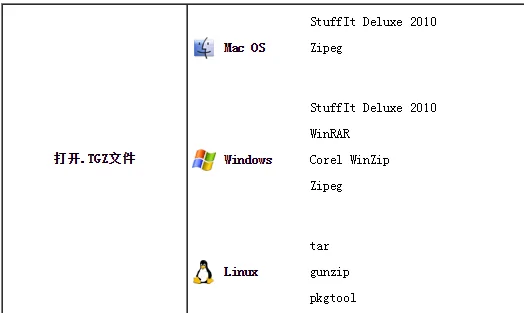What is the format of linux tgz
In Linux, tgz is a compressed file format; TGZ files are Gzip-compressed Tar files. Multiple files generated by TAR file archiving are compressed by Gzip and classified into one file, thereby reducing the space occupied. In Linux, you can use the tar command to decompress tgz files. The syntax is "tar zxvf file name.tgz -C /specify path" or "tar zxvf file name.tgz -C ./".

#The operating environment of this tutorial: linux7.3 system, Dell G3 computer.
tgz is a compressed file format.
TGZ files are Gzip-compressed Tar files. The files
.tar.gz, or .tgz are generally files compressed using tar and gzip under UNIX.
The .TAR file archive in the Unix system is compressed by Gnu Zip (.GZIP). Multiple files generated by the TAR file archive are compressed by Gzip and classified into one file, thereby reducing the space occupied.
Open the TGZ file. Different systems have slightly different opening methods. The required applications are as shown below:

Linux decompression.tgz , .tar.gz file
1. Linux operation .tgz file
1. Unzip the .tgz file:
(1) Extract to the current folder
Command: tar zxvf File name.tgz -C ./
eg:tar zxvf demo. tgz -C ./
(2) Extract to the specified folder
Command: tar zxvf file name.tgz -C /specified path
eg: Unzip to the home directory: tar zxvf simple-examples.tgz -C /Home
2. Operating the .tar.gz file under Linux
1. Compress .tar.gz file
Command: tar -zcvf Compressed file name.tar.gz Compressed file name
eg:tar -zcvf demo.tar.gz test
2. Decompression command:
Command: tar -zxvf Compressed file name.tar.gz -C /Specify path
eg:tar -zxvf demo.tar.gz -C /home
Supplement: tar detailed parameter introduction
-c: Create a compressed archive
-x: Decompress
-t: View the content
-r: Append to the end of the compressed archive file File
-u: Update the files in the original compressed package
These five are independent commands. One of them is used for compression and decompression. It can be used in conjunction with other commands but only one of them can be used. The following parameters are optional when compressing or decompressing archives as needed.
-z:
with gzip attribute -j:
with bz2 attribute -Z:
with compress attribute -v: Display all processes
-O: File Unpack to standard output
The following parameter -f is required
-f: Use the file name. Remember, this parameter is the last parameter, and can only be followed by the file name.
# tar -cf all.tar *.jpg
This command is to package all .jpg files into a package named all.tar. -c means generating a new package, and -f specifies the file name of the package.
# tar -rf all.tar *.gif
This command adds all .gif files to the all.tar package. -r means adding files.
# tar -uf all.tar logo.gif
This command is to update the logo.gif file in the original tar package all.tar. -u means to update the file.
# tar -tf all.tar
This command is to list all the files in the all.tar package, -t means to list the files
# tar -xf all. tar
This command is to extract all the files in the all.tar package. -t means to unpack
Compression
tar -cvf jpg.tar *.jpg //Package all jpg files in the directory into jpg.tar
tar -czf jpg.tar.gz *.jpg //Package all jpg files in the directory into jpg .tar, and compress it with gzip to generate a gzip-compressed package, named jpg.tar.gz
tar -cjf jpg.tar.bz2 *.jpg //All jpg in the directory After the file is packaged into jpg.tar, and compressed with bzip2, a bzip2-compressed package is generated and named jpg.tar.bz2
tar -cZf jpg.tar.Z *.jpg // After all the jpg files in the directory are packaged into jpg.tar, and compressed with compress, a umcompress-compressed package is generated, named jpg.tar.Z
rar a jpg.rar *.jpg // For compression in rar format, you need to download rar for linux first
zip jpg.zip *.jpg //For compression in zip format, you need to download zip for linux
and decompress it
tar -xvf file.tar //Extract tar package
tar -xzvf file.tar.gz //Extract tar.gz
tar -xjvf file.tar.bz2 //Extract tar.bz2
tar -xZvf file.tar.Z //Extract tar.Z
unrar e file.rar // Unzip rar
unzip file.zip //Unzip zip
Summary
1. *.tar Use tar -xvf Decompress
2, *.gz. Use gzip -d or gunzip to decompress
3, *.tar.gz and *.tgz. Use tar -xzf to decompress
4, * .bz2 Use bzip2 -d or bunzip2 to decompress
5, *.tar.bz2 use tar -xjf to decompress
6, *.Z use uncompress to decompress
7, *.tar.Z Use tar -xZf to decompress
8, *.rar Use unrar e to decompress
9, *.zip Use unzip to decompress
Related recommendations: "Linux video tutorial》
The above is the detailed content of What is the format of linux tgz. For more information, please follow other related articles on the PHP Chinese website!

Hot AI Tools

Undresser.AI Undress
AI-powered app for creating realistic nude photos

AI Clothes Remover
Online AI tool for removing clothes from photos.

Undress AI Tool
Undress images for free

Clothoff.io
AI clothes remover

Video Face Swap
Swap faces in any video effortlessly with our completely free AI face swap tool!

Hot Article

Hot Tools

Notepad++7.3.1
Easy-to-use and free code editor

SublimeText3 Chinese version
Chinese version, very easy to use

Zend Studio 13.0.1
Powerful PHP integrated development environment

Dreamweaver CS6
Visual web development tools

SublimeText3 Mac version
God-level code editing software (SublimeText3)

Hot Topics
 What computer configuration is required for vscode
Apr 15, 2025 pm 09:48 PM
What computer configuration is required for vscode
Apr 15, 2025 pm 09:48 PM
VS Code system requirements: Operating system: Windows 10 and above, macOS 10.12 and above, Linux distribution processor: minimum 1.6 GHz, recommended 2.0 GHz and above memory: minimum 512 MB, recommended 4 GB and above storage space: minimum 250 MB, recommended 1 GB and above other requirements: stable network connection, Xorg/Wayland (Linux)
 Linux Architecture: Unveiling the 5 Basic Components
Apr 20, 2025 am 12:04 AM
Linux Architecture: Unveiling the 5 Basic Components
Apr 20, 2025 am 12:04 AM
The five basic components of the Linux system are: 1. Kernel, 2. System library, 3. System utilities, 4. Graphical user interface, 5. Applications. The kernel manages hardware resources, the system library provides precompiled functions, system utilities are used for system management, the GUI provides visual interaction, and applications use these components to implement functions.
 How to run java code in notepad
Apr 16, 2025 pm 07:39 PM
How to run java code in notepad
Apr 16, 2025 pm 07:39 PM
Although Notepad cannot run Java code directly, it can be achieved by using other tools: using the command line compiler (javac) to generate a bytecode file (filename.class). Use the Java interpreter (java) to interpret bytecode, execute the code, and output the result.
 vscode terminal usage tutorial
Apr 15, 2025 pm 10:09 PM
vscode terminal usage tutorial
Apr 15, 2025 pm 10:09 PM
vscode built-in terminal is a development tool that allows running commands and scripts within the editor to simplify the development process. How to use vscode terminal: Open the terminal with the shortcut key (Ctrl/Cmd). Enter a command or run the script. Use hotkeys (such as Ctrl L to clear the terminal). Change the working directory (such as the cd command). Advanced features include debug mode, automatic code snippet completion, and interactive command history.
 How to check the warehouse address of git
Apr 17, 2025 pm 01:54 PM
How to check the warehouse address of git
Apr 17, 2025 pm 01:54 PM
To view the Git repository address, perform the following steps: 1. Open the command line and navigate to the repository directory; 2. Run the "git remote -v" command; 3. View the repository name in the output and its corresponding address.
 vscode cannot install extension
Apr 15, 2025 pm 07:18 PM
vscode cannot install extension
Apr 15, 2025 pm 07:18 PM
The reasons for the installation of VS Code extensions may be: network instability, insufficient permissions, system compatibility issues, VS Code version is too old, antivirus software or firewall interference. By checking network connections, permissions, log files, updating VS Code, disabling security software, and restarting VS Code or computers, you can gradually troubleshoot and resolve issues.
 Where to write code in vscode
Apr 15, 2025 pm 09:54 PM
Where to write code in vscode
Apr 15, 2025 pm 09:54 PM
Writing code in Visual Studio Code (VSCode) is simple and easy to use. Just install VSCode, create a project, select a language, create a file, write code, save and run it. The advantages of VSCode include cross-platform, free and open source, powerful features, rich extensions, and lightweight and fast.
 Can vscode be used for mac
Apr 15, 2025 pm 07:36 PM
Can vscode be used for mac
Apr 15, 2025 pm 07:36 PM
VS Code is available on Mac. It has powerful extensions, Git integration, terminal and debugger, and also offers a wealth of setup options. However, for particularly large projects or highly professional development, VS Code may have performance or functional limitations.






